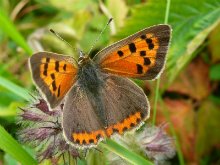
Widespread and common
Distribution and Status
The Small Copper is widely distributed in the two counties except in the agricultural areas of north-east Hertfordshire. It forms discrete colonies and not usually seen in any great numbers. Since the peak in the mid 1990s the butterfly declined dramatically in abundance although no significant reduction in range was detected. However populations strengthened remarkably in 2017, 2018 and 2020 although significant drops in numbers are evident since then until there was a notable bounce back in 2023. The best sites for this species appear now to be Nomansland Common, Patmore Heath and Chorleywood Common in Hertfordshire, and Osterley Park in Middlesex.

Habitat Requirements
A wide variety of habitats such as unimproved grassland, woodland rides, roadside verges and waste ground. It prefers sunny open situations containing bare patches and low-lying flowers. It may occasionally be found in gardens where the food-plant is present
Larval Foodplants
Common Sorrel Rumex acetosa on chalky soils and Sheep's Sorrel Rumex acetosella on the more acidic soils. Other Dock Rumex spp. plants may also be used
Adult Food Sources
Common Ragwort Senecio jacobaea, Iceplant Sedum spectabile, Buddleia Buddleja davidii
Behaviour/Observation notes
The Small Copper is an active butterfly, particularly males who vigorously defend their territories close to the ground over bare patches. They often bask with their wings open and are easy to photograph if approached carefully. Females are less active as they spend much of their time feeding and activities associated with egg-laying
Life History
There are normally three generations a year with peaks in late May, first half of August, and September and early October. Very occasionally a partial fourth brood emerges in November. Eggs are usually laid singly under a leaf of the foodplant, preferably in sunny locations. Larvae feed on the undersides of the leaves which form transparent grooves when seen from above. The last generation of larvae hibernate until the following spring when pupae are formed low down in the vegetation

Further information
Photo gallery
Branch Annual Report (2023)
UK distribution map
Full list of larval hostplants (Lycaenidae)
Stevenage butterflies - additional notes
Account for 2022